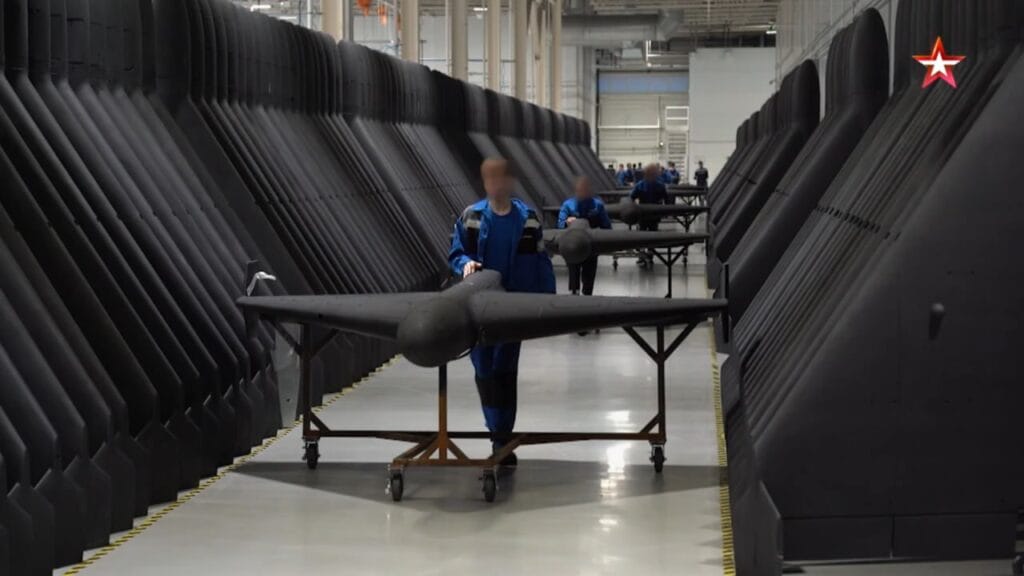Based on the latest available information (as of July 2025), Russia’s drone production capabilities—developed with Iran’s assistance—have dramatically expanded, with significant operational impacts on the Ukraine conflict. Here are the key updates:
⚙️ 1. Current Production Scale
- Daily Output: Russia is now producing ~170 Shahed-type drones (Geran-2) per day at the Alabuga facility in Tatarstan, with plans to increase to 190/day by late 2025 .
- Surge Capacity: Industry projections indicate potential for 500 drones/day, enabling multi-thousand-drone swarm attacks .
- Monthly Totals: Combined with decoy drones (e.g., Gerbera), monthly production exceeds 5,000 units (2,700 Geran-2 strike drones + 2,500 decoys) .
🏭 2. Alabuga Factory Operations
- Infrastructure: The Alabuga Special Economic Zone functions as a semi-militarized hub with assembly lines for fuselages, engines, and composite materials. Satellite imagery confirms rapid expansion since 2023 .
- Labor Practices: Relies on migrant workers under strict surveillance, with reports of coercive conditions .
- Covert Setup: Initial phases involved Iranian tech transfers and personnel (2022–2023), but Russia now dominates production independently .
🚀 3. Technological Upgrades
Russia has significantly enhanced Iranian designs:
- Geran-3 Development: Jet-powered variant (replacing piston engines) for higher speed and altitude, evading air defenses .
- Warhead Modifications: Increased payloads from 50 kg to 90 kg, including thermobaric and tungsten shrapnel options for greater destructiveness .
- Navigation & Electronics: Upgraded to 16-array GNSS antennas (countering jamming), real-time video via Starlink/4G modems, and AI-targeting systems using NVIDIA Jetson processors .
Table: Evolution of Shahed-136/Geran Drones
| Feature | Original (Iran) | Geran-2 (Russia) | Geran-3 (Russia) |
|---|---|---|---|
| Warhead | 50 kg | 52–90 kg | 90 kg |
| Speed | 185 km/h | 185 km/h | 300+ km/h (jet) |
| Range | 2,500 km | 1,000–2,500 km | Classified |
| Guidance | Basic GPS/GLONASS | AI-enhanced + EW resistance | Real-time video + AI |
| Unit Cost | $10k–$50k | $30k–$80k | $80k+ |
| *Sources: * |
💥 4. Tactical Deployment Shifts
- Decoy Swarms: Russia deploys 10:1 decoy-to-strike drone ratios (e.g., $10k Gerbera drones) to exhaust Ukrainian air defenses. A July 2025 attack used 728 drones in a single night .
- Attack Patterns: Drones now fly at mixed altitudes/directions, avoiding searchlights and leveraging night camouflage .
💰 5. Sanctions Evasion & Financial Networks
- Gold Payments: Russia transferred $104 million in gold bars to Iran’s Sahara Thunder via UAE intermediaries to bypass dollar-based sanctions .
- Entity Cycling: After U.S. sanctions, Sahara Thunder liquidated and likely reemerged under a new name .
🔥 6. Impact on Ukraine
- Strike Intensity: Kyiv faces ~110 drones/night (up from 60 in 2023), overwhelming defenses .
- Infrastructure Damage: Drones systematically target power grids, causing blackouts .
- Production Disparity: Ukraine produces ~100 long-range drones/day—one-third of Russia’s output .
🔮 7. Future Outlook
- Geran-3 Rollout: Mass production expected by late 2025, enhancing strike speed/payload .
- Swarm Tactics: Bundeswehr warns of 2,000-drone simultaneous attacks to cripple defenses .
- Cost Challenges: Upgrades may raise drone prices, potentially limiting scalability .
💎 Conclusion
The Russia-Iran drone axis has transformed Alabuga into a pivotal warfare asset, enabling high-volume, low-cost strikes that strain Ukraine’s defenses. Despite sanctions, covert financing and tech adaptation sustain production. This collaboration signals a strategic shift: authoritarian states leveraging asymmetrical partnerships to challenge Western military dominance .




